Google Cloud vs. AWS: A Cost Comparison Showdown
Everyone wants to know which cloud provider is the best and least expensive. AWS is the market leader, but Google Cloud has been gaining ground rapidly. Even in the face of our recent economic climate, Google Cloud’s quarterly revenue growth was most recently 32% compared to AWS’s 20%.¹
In this article, we’ll be looking at three of the most popular services that each provider offers, and comparing how much they cost. For AWS, that’s EC2, RDS and S3, translating to GCE, Cloud SQL and GCS in Google Cloud. You might be surprised how close the costs can be, but there are some key differentiators across both platforms.
Terms to Know
First, let’s go over some terms used in this article. List price is the price at which both providers sell their service, without any discounts. Additionally, both Google Cloud and AWS offer discounts based on committing to their services for a certain amount of time. In Google Cloud, these are the aptly-named Committed Use Discounts (CUD), while AWS calls them Reserved Instances (RI) and Savings Plans. Google Cloud also has a unique discount mechanism called Sustained Use Discounts (SUDs), which applies a discount automatically on most VMs as they’re used.
In addition, your company might have its own contract with the provider that may or may not include additional discounts or credits, usually called an Enterprise Discount Agreement on AWS or Cloud Commitment Contract on Google Cloud.
Comparing Costs
Machines
Now, let’s get into the nuts and bolts and see which of these two providers is actually cheaper.
First, let’s take a look at Amazon’s Elastic Compute Cloud (EC2) and Google Compute Engine (GCE), comparing the popular AWS m5 and Google N2 machines at list price, no discounts, running in US East 1 (a popular Region for both providers). Both the m5 and N2 machines are the general-purpose machines for their respective providers, which makes them popular choices for a variety of workloads. The machines here will be running the free Linux OS, so we’re just looking at instance pricing:

Not really much of a difference – roughly 1% at list price. The N2 machines, however, also qualify for SUDs, which provide an additional 20% discount² automatically without any commitment (something AWS has no equivalent for). Let’s see how that looks visually:
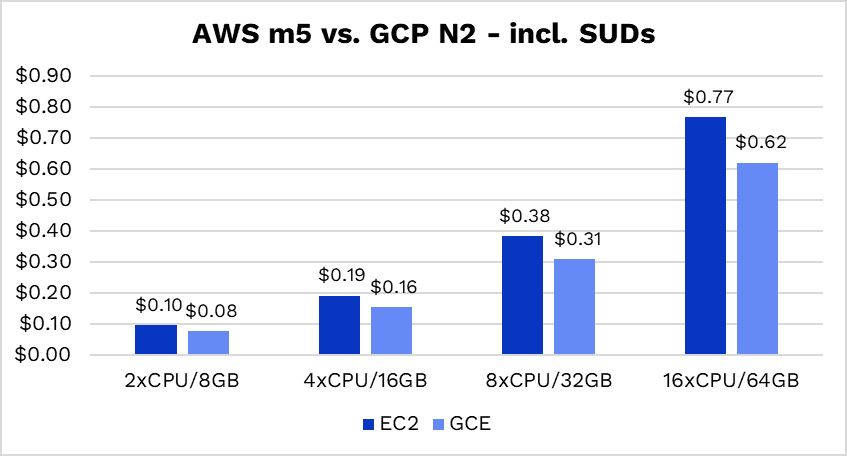
So with SUDs, the N2 is actually about 20% less expensive than the m5. Note that for machines that don’t run 24/7, this discount will vary a bit, so the costs will trend more towards equal between the platforms.
Now, let’s compare using the second generation cost-optimized machines from Google, the E2. E2s and m5s have roughly the same computing power and memory: The E2 Machines use Intel and AMD Rome processors, while the N2s use Cascade Lake (Default) or Ice Lake processors. Processing power can be the same for both, with the N2’s having a higher available clock speed if desired. E2’s are not eligible for SUDs like N2s are, but let’s take a look at the costs:
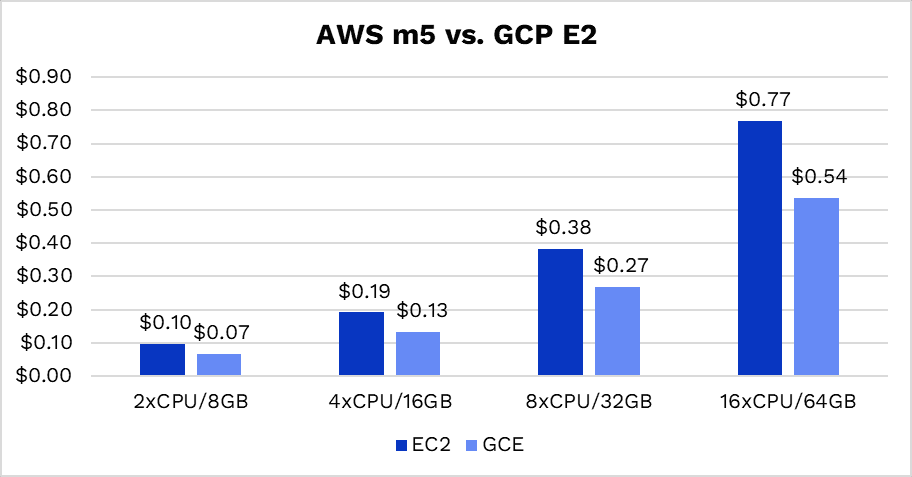
A significant difference! Each one of the E2 machines is about 30% cheaper than its m5 counterpart. On top of that, E2’s qualify for CUDs, and m5’s qualify for RIs or Savings Plans, which provide further discounts:³
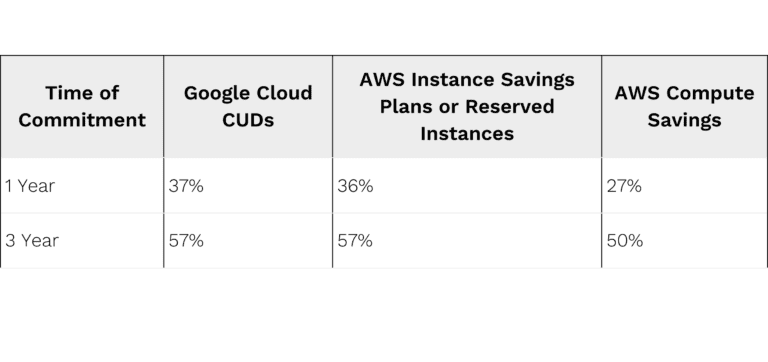
Both Google Cloud and AWS offer potentially similar discount rates, and since the E2s are already cheaper at list price than the m5s, the E2s will be the most cost-effective option. In our comparison of the most popular machine types, Google Cloud is the clear winner from a cost perspective.
Database Services
Let’s take a look at Amazon’s Relational Database Service (RDS) and Google’s Cloud SQL at list price. We’ll be using the m5 machine for AWS. Google’s Cloud SQL machines are Variable, meaning they are not preset machines, but are priced per CPU and unit of memory provisioned. This allows the user to customize their Cloud SQL machines to fit their exact needs. To keep things consistent, we’ll make it so our Cloud SQL configuration has the same CPU and RAM as the m5 machine we’re comparing it to:

SSH and Zero-Trust Networking
We see some savings using Cloud SQL: an average of 7% in this comparison. However, the likeliest scenario is that you won’t end up paying list price. Let’s take a look at the same comparison including a 1-year CUD for Cloud SQL and a 1-year RI for RDS:
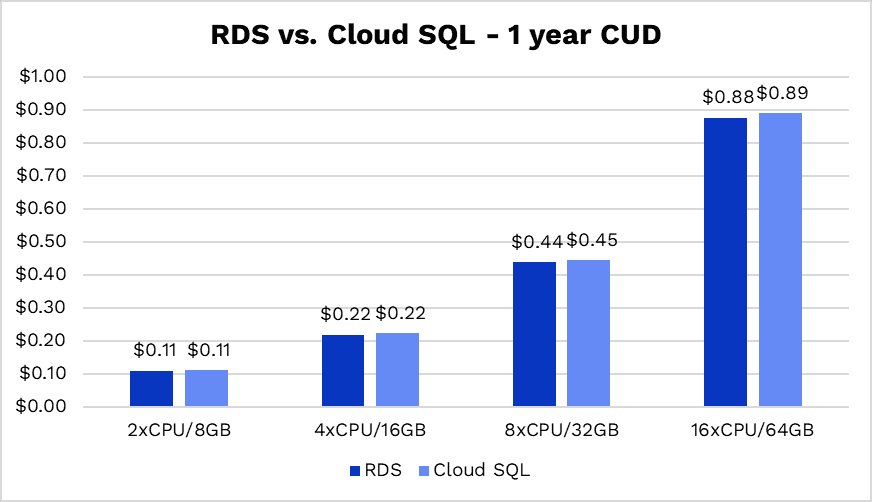
We almost have parity, with RDS being ever so slightly cheaper across all machines. However, one key benefit of Cloud SQL is ease of scalability. In RDS, you’d need to migrate to a new machine if your current one does not satisfy your processing requirements. With Cloud SQL, it’s as simple as making an API call and Google Cloud performs a Live Migration of your instance, with under one minute of downtime required.⁴
In addition, AWS does not have 3 year commitment discounts available for the m5 machines like Google Cloud does. On top of that, Google Cloud commitments in Cloud SQL are also not locked to a specific machine type, only total spend in a Region. In AWS, Clients cannot change RDS machine types or the RI slot will be wasted. So, nabbing that 52% 3-year commitment discount is possible on Google Cloud, and actually safe to do in many cases. Here’s a look at all the commitment discounts available for each provider:

There’s no one clear winner here. Google’s Cloud SQL is a bit cheaper at list price, has a price advantage with 3-year CUDs applied, and has an advantage in its scalability and customizability. But AWS wins when 1-year commitments are applied. Here’s a look at the maximum savings you can achieve on both AWS and Google Cloud:
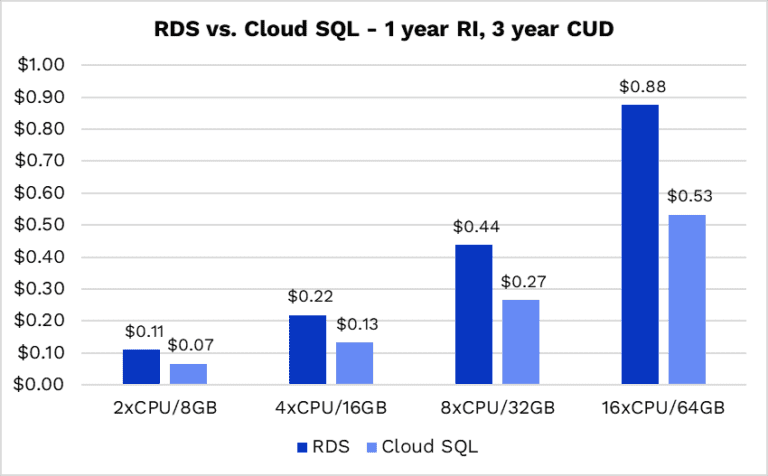
Storage
Let’s take a look at storage. AWS’s Simple Storage Service (S3) and Google Cloud’s Cloud Storage have pricing structured differently. AWS has a flat rate per hour for all frequently accessed data, split into 3 tiers. The most basic tier is $.023 per GB, which is available for the first 50 TB of usage per month. The next tier is $.022 per GB, for the next 450 TB, followed by $.021 per GB for over 500 TB of storage per month:
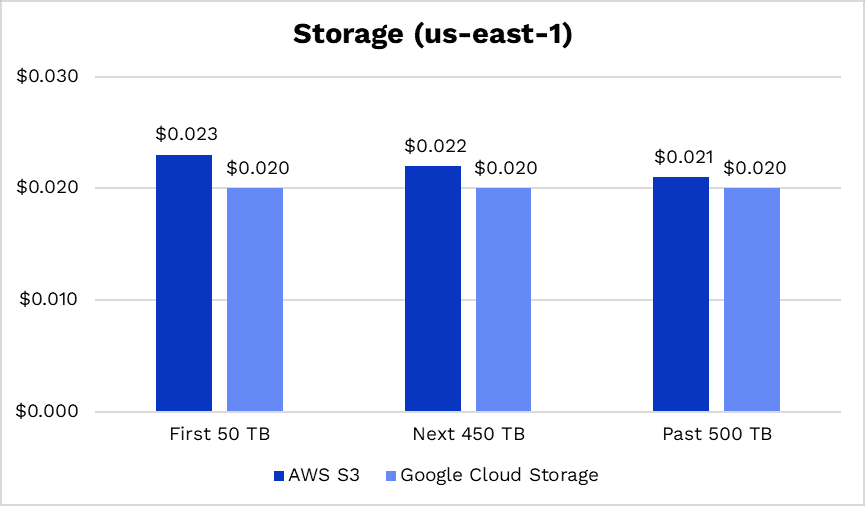
For Google Cloud, prices are static throughout the entirety of US and North America based regions. Standard Storage ranges from $0.020 per GB to $0.023 per GB, depending on the region. In the us-east-1 region, if you store 600 TB of data per month, that would cost you about $12 on Google Cloud, versus $13.25 on AWS, or roughly a 10% savings per month.
Disk Storage
In addition to Cloud Storage and S3, Both Google Cloud and AWS have storage services that specifically pair with virtual machines to provide storage for those applications. These services are called Persistent Disk (PD) and Elastic Block Store (EBS) for Google and AWS, respectively.
PD has many different types of storage offerings, so we’ll take a look at the most popular ones that pair with machines. Specifically, we’ll be comparing EBS’s gp2 and gp3 storage to PD’s Balanced PD. These are some of the most common storage types for each service, and are fairly comparable to each other. Both EBS’s gp2 and gp3 and Google’s Balanced PD are backed by SSD hardware, and have similar throughputs and volume. The differences between gp2 and gp3 are minor, with gp3 coming in at a slightly lower price point than gp2, providing higher baseline performance, but with the trade-off being that gp3 has slightly lower maximum limits on performance and capacity5. Here’s a look at how much each option costs, per GB-month, in the us-east1 region, the same region we used for the earlier comparisons with the machines:

Balanced PD is level on price with gp2 per gb-month, and 25% more expensive than gp3. However, just looking at these prices alone doesn’t tell the whole story.
Let’s take a look at how much each option will cost at 500 GB of storage. Crucially, however, we will need to take a look at those options when paired with a machine. We’ll use EC2 and Compute Engine machines of the same size, used for 730 hours (100% uptime in one month) at list price:

Even though EBS’s most cost effective option is cheaper than Balanced PD, we still find that the machine cost offsets it entirely, and Google’s solutions are still cheaper for the same performance – even with a pretty hefty volume attached.
Let’s do the same exercise for the database options, which also use EBS and PD, at list price:
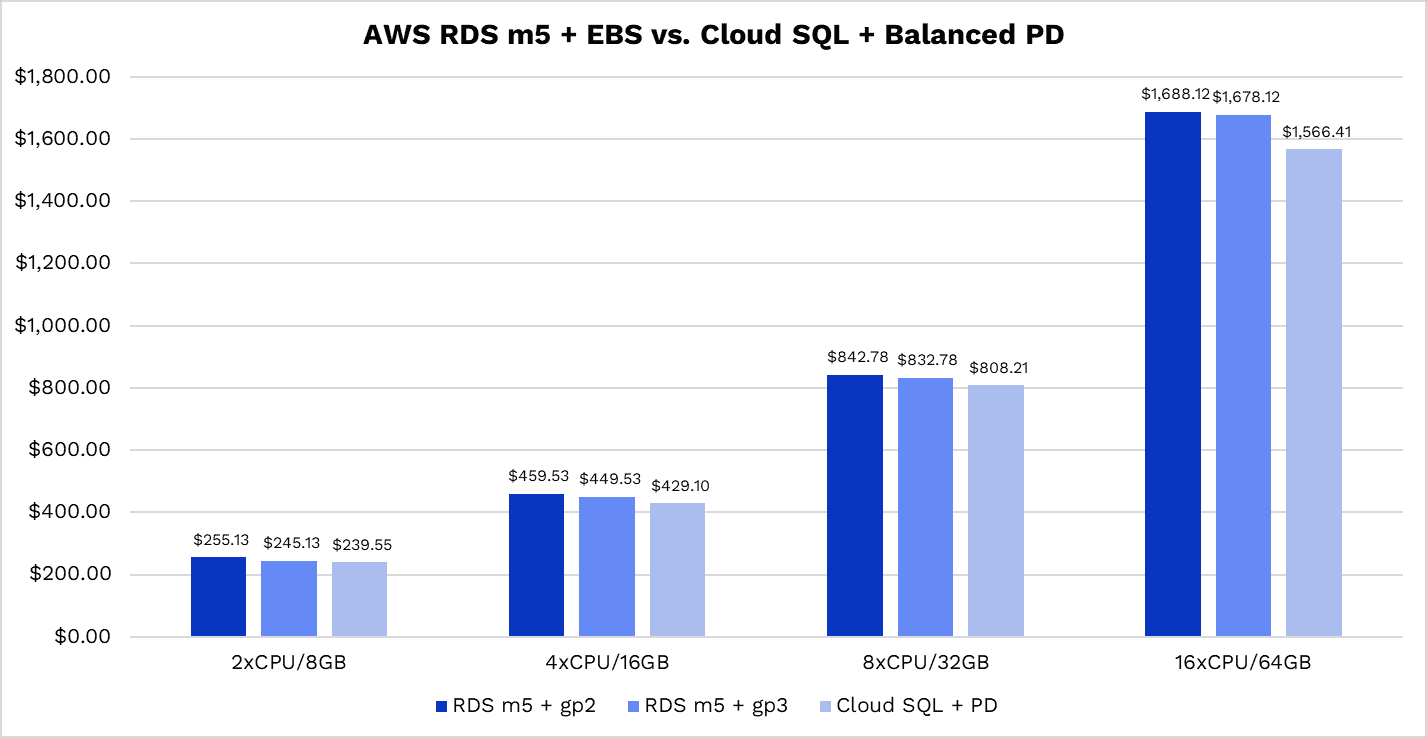
Same result as above, we find that overall, Google’s offerings are cheaper than AWS for a similar performance.
Conclusions
In this analysis of popular compute, DB, and storage solutions, Google Cloud edges out AWS from a price standpoint.

Not surprisingly given the data above, in most of 66degrees’ analyses of our clients’ real-life workloads, Google Cloud averages ~20% lower costs overall compared to AWS. Each of your cloud workloads demands its own technical and economic assessments before you select a cloud provider, but the high likelihood of 20%+ savings means Google Cloud is worth a very close look.
Analyze Your Workloads
Want to know exactly how much your on-prem, AWS, or Azure workloads would cost on Google Cloud? We offer free Total Cost of Ownership (TCO) analysis to help your organization decide what’s right for you. Contact hello@66degrees.com to learn more.



